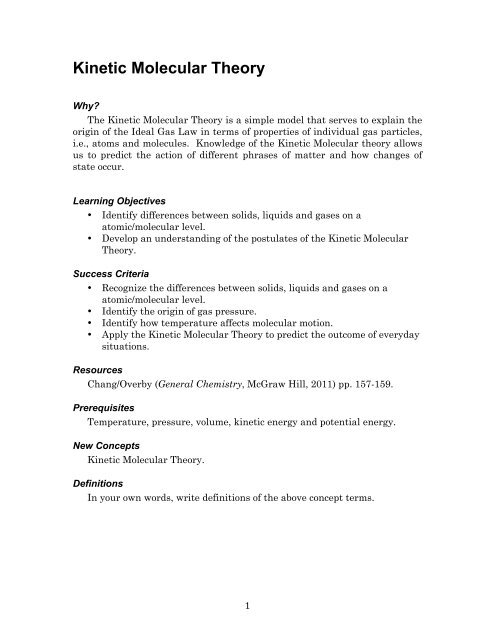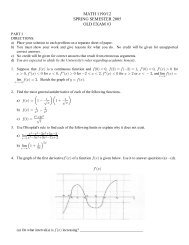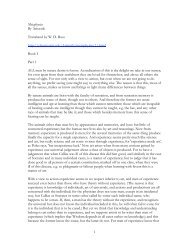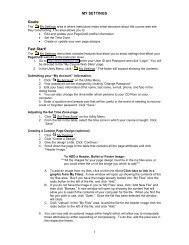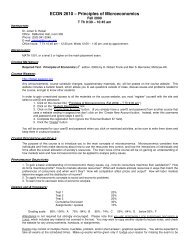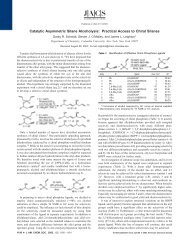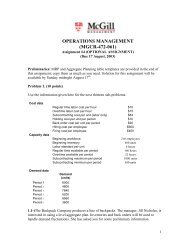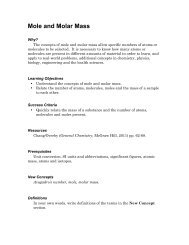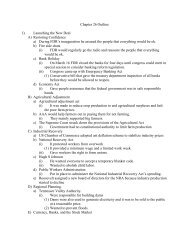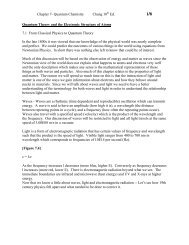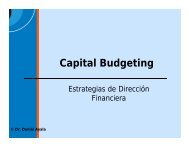Kinetic Molecular Theory - PageOut
Kinetic Molecular Theory - PageOut
Kinetic Molecular Theory - PageOut
- No tags were found...
Create successful ePaper yourself
Turn your PDF publications into a flip-book with our unique Google optimized e-Paper software.
<strong>Kinetic</strong> <strong>Molecular</strong> <strong>Theory</strong>Why?The <strong>Kinetic</strong> <strong>Molecular</strong> <strong>Theory</strong> is a simple model that serves to explain theorigin of the Ideal Gas Law in terms of properties of individual gas particles,i.e., atoms and molecules. Knowledge of the <strong>Kinetic</strong> <strong>Molecular</strong> theory allowsus to predict the action of different phrases of matter and how changes ofstate occur.Learning Objectives• Identify differences between solids, liquids and gases on aatomic/molecular level.• Develop an understanding of the postulates of the <strong>Kinetic</strong> <strong>Molecular</strong><strong>Theory</strong>.Success Criteria• Recognize the differences between solids, liquids and gases on aatomic/molecular level.• Identify the origin of gas pressure.• Identify how temperature affects molecular motion.• Apply the <strong>Kinetic</strong> <strong>Molecular</strong> <strong>Theory</strong> to predict the outcome of everydaysituations.ResourcesChang/Overby (General Chemistry, McGraw Hill, 2011) pp. 157-159.PrerequisitesTemperature, pressure, volume, kinetic energy and potential energy.New Concepts<strong>Kinetic</strong> <strong>Molecular</strong> <strong>Theory</strong>.DefinitionsIn your own words, write definitions of the above concept terms.1
Model 1: Representatives of Atoms in Different PhrasesKey Questions1. What are the key characteristics of atoms and molecules in gases, liquidsand solids? In Table 1 below, describe the characteristics of particles foreach phase of matter based on Model 1. Be specific with regard to spacing,the potential of particle movement, and whether or not particles will fillthe container.SPACINGTable 1: Characteristics of the Phases of MatterSOLID LIQUID GASPOTENTIAL FORMOVEMENTFILLING ACONTAINER2
2. In which phase of matter is there the least spacing between particles?3. In which phase of matter is there the most potential for movement?4. Which phase of matter does not have a definite shape yet the particles willnot fill the container?5. In terms of spacing, what would be necessary to change from a solid to aliquid? What is the process called and how is this accomplished?6. In terms of spacing, what would be necessary to change from a liquid to agas? What is the process called and how is this accomplished?7. In terms of spacing, what would be necessary to change from a liquid to asolid? What is the process called and how is this accomplished?Model 2: <strong>Kinetic</strong> <strong>Molecular</strong> <strong>Theory</strong>POSTULATES OF THE KINETIC MOLECULAR THEORY1. Gases consist of tiny particles (atoms or molecules).2. These particles are so small compared with the distances between them,that the volume (size) of the individual particles can be assumed to benegligible (zero).3. The particles are in constant random motion, colliding with the walls ofthe container. These collisions cause the pressure exerted by the gas.4. There is no force of attraction or repulsion between gas particles.5. Collisions between gas particles or collisions with the walls of thecontainer are perfectly elastic. None of the energy of a gas particle is lostwhen it collides with another particle or with the walls of the container.6. The average kinetic energy of a collection of gas particles depends on thetemperature of the gas and nothing else.3
Key Questions1. What causes a gas to exert pressure when confined in a container?2. How does the total volume of gas particles compare to the volume of thespace between the gas particles?3. As the temperature of a gas decreases, what chane occurs in the amount ofkinetic energy?4. What property of gas particles is measured by temperature?5. What is the relationship between temperature and molecular motion?6. In terms of the <strong>Kinetic</strong> <strong>Molecular</strong> <strong>Theory</strong> of gases, how can an increase inthe temperature of a confined gas in a rigid container cause an increase inthe pressure of the gas?4
Applications1. There is a government warning on all aerosol cans that states: “Do notstore at a temperature above 120 °F (50 °C)”.a) Explain why this warning is required in terms of the relationshipbetween temperature and pressure and the <strong>Kinetic</strong> <strong>Molecular</strong> <strong>Theory</strong>.b) What could happen if the can were to be heated above 120 °F (50 °C)”.2. What could happen to a completely inflated balloon if it were taken frominside a house to the outside in the middle of January in Minnesota?Explain this prediction in terms of the <strong>Kinetic</strong> <strong>Molecular</strong> <strong>Theory</strong>.3. Why do manufacturers of tires suggest that tire pressure be checked beforea car has been driven any distance?5


